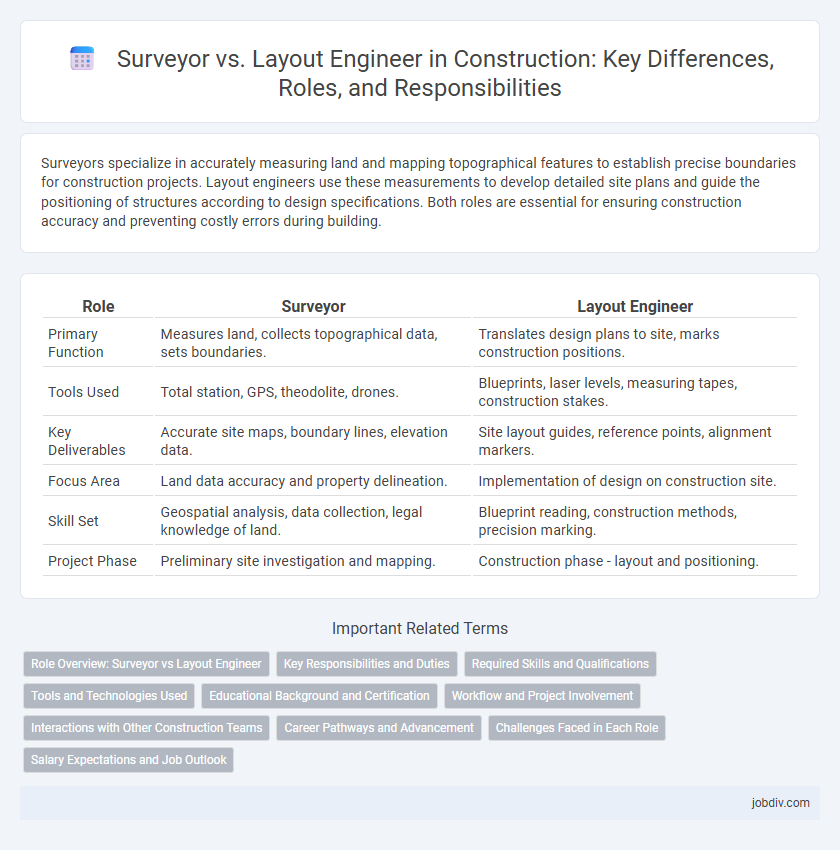Surveyors specialize in accurately measuring land and mapping topographical features to establish precise boundaries for construction projects. Layout engineers use these measurements to develop detailed site plans and guide the positioning of structures according to design specifications. Both roles are essential for ensuring construction accuracy and preventing costly errors during building.
Table of Comparison
| Role | Surveyor | Layout Engineer |
|---|---|---|
| Primary Function | Measures land, collects topographical data, sets boundaries. | Translates design plans to site, marks construction positions. |
| Tools Used | Total station, GPS, theodolite, drones. | Blueprints, laser levels, measuring tapes, construction stakes. |
| Key Deliverables | Accurate site maps, boundary lines, elevation data. | Site layout guides, reference points, alignment markers. |
| Focus Area | Land data accuracy and property delineation. | Implementation of design on construction site. |
| Skill Set | Geospatial analysis, data collection, legal knowledge of land. | Blueprint reading, construction methods, precision marking. |
| Project Phase | Preliminary site investigation and mapping. | Construction phase - layout and positioning. |
Role Overview: Surveyor vs Layout Engineer
Surveyors specialize in measuring and mapping land boundaries, ensuring precise topographical data for construction projects using tools like total stations and GPS equipment. Layout Engineers focus on transferring building plans onto the construction site, marking exact locations for structures according to architectural and engineering specifications. Both roles are essential for accurate project execution, with surveyors establishing foundational data and layout engineers translating design intent into physical site markers.
Key Responsibilities and Duties
Surveyors specialize in precise measurement and mapping of land boundaries, topography, and construction sites, ensuring accurate data for project planning and legal documentation. Layout Engineers translate architectural and engineering designs into physical markers, guiding construction teams by marking locations, elevations, and alignments for structural elements. Both roles collaborate closely, with Surveyors providing foundational geographic data and Layout Engineers applying that data to direct on-site construction activities.
Required Skills and Qualifications
Surveyors require strong expertise in geospatial measurement, proficiency with GPS and total station equipment, and a solid understanding of land laws and regulations. Layout Engineers must possess advanced skills in reading and interpreting blueprints, construction drawings, and engineering plans, along with proficiency in CAD software and precise mathematical abilities. Both roles demand attention to detail, excellent communication skills, and fieldwork experience in construction site environments.
Tools and Technologies Used
Surveyors primarily use total stations, GPS equipment, theodolites, and laser scanners to accurately measure land and establish precise geographical data for construction projects. Layout engineers rely on computer-aided design (CAD) software, Building Information Modeling (BIM), and robotic total stations to translate survey data into detailed construction plans and on-site guide points. Both professionals integrate Geographic Information Systems (GIS) and drones to enhance accuracy and efficiency in site layout and measurement tasks.
Educational Background and Certification
Surveyors typically hold degrees in geomatics, surveying, or civil engineering and often require certifications such as the Professional Land Surveyor (PLS) license to ensure precision in land measurement. Layout engineers usually have educational backgrounds in civil or construction engineering and may obtain certifications like the Certified Construction Manager (CCM) or Project Management Professional (PMP) to demonstrate expertise in project planning and site layout. Both roles demand specialized training and credentialing to maintain accuracy and compliance in construction projects.
Workflow and Project Involvement
Surveyors establish precise site measurements and boundaries, ensuring accurate data collection critical for project planning, while layout engineers translate these measurements into physical guides for construction teams to follow during building. Surveyors primarily operate during the initial phases for site assessment and mapping, whereas layout engineers are involved continuously throughout construction to set out exact positions of structures. Both roles collaborate closely to maintain alignment with design specifications, optimizing workflow efficiency and minimizing errors on-site.
Interactions with Other Construction Teams
Surveyors coordinate closely with architects and civil engineers to establish precise reference points used in construction, ensuring alignment with design plans and regulatory requirements. Layout engineers translate survey data into detailed site markings that guide construction crews during foundation laying and structural installations. Effective communication between surveyors, layout engineers, and project managers is critical for minimizing errors and maintaining construction schedules.
Career Pathways and Advancement
Surveyors typically start as assistants or technicians before advancing to licensed surveyors, specializing in land measurement, property boundaries, and legal documentation. Layout engineers begin as junior engineers or assistants, progressing through roles focused on site planning, structural alignment, and coordination with construction teams. Career advancement for both roles depends on gaining relevant certifications, field experience, and expertise in construction technology and project management software.
Challenges Faced in Each Role
Surveyors often face challenges related to precise measurement and data accuracy in varied terrains, requiring advanced skills in GPS and total station technology. Layout engineers encounter difficulties in interpreting design plans accurately on-site, ensuring alignment with construction specifications and managing real-time adjustments. Both roles demand meticulous attention to detail and strong problem-solving abilities to address unforeseen site conditions and coordinate effectively with the construction team.
Salary Expectations and Job Outlook
Surveyors typically earn an average salary ranging from $50,000 to $75,000 annually, while layout engineers command higher salaries between $70,000 and $95,000 due to their specialized technical skills in construction design and site planning. The job outlook for surveyors is steady with consistent demand driven by infrastructure projects and land development, whereas layout engineers experience faster growth prospects linked to advanced construction technologies and complex project requirements. Both roles are essential in construction, but layout engineers benefit from broader opportunities in design innovation and higher compensation trends.
Surveyor vs Layout Engineer Infographic

 jobdiv.com
jobdiv.com